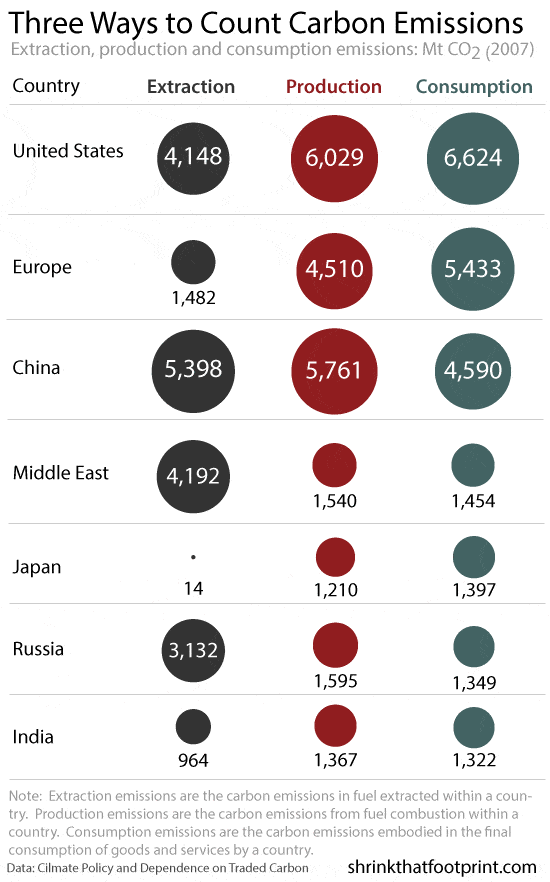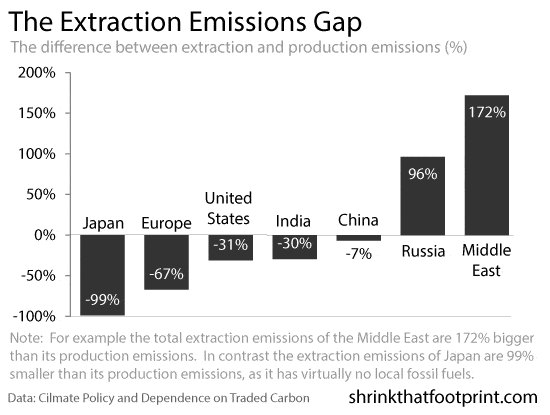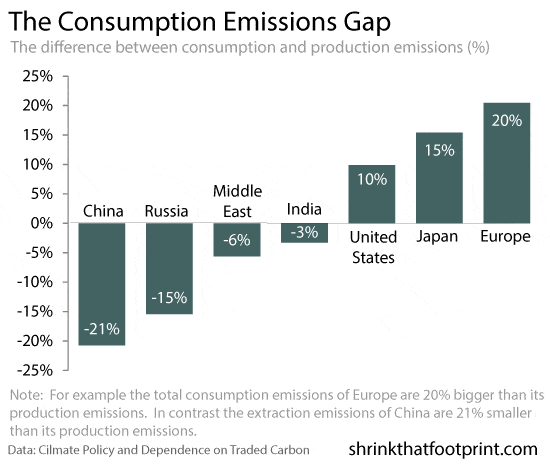If you’ve ever been on the tube in London both the sign-writer and the conductor will have reminded you to ‘mind the gap‘. The gap in question is the one between the platform and the train. To board the train safely you need to mind the gap. Climate policy has some fast growing carbon gaps.
In this third post in our series The Carbon Trade we are going to look at the gaps between how much carbon a country extracts, produces and consumes. These three ways of accounting for a nation’s carbon emissions all help to understand its climate impact and are useful when designing climate policy.
Carbon accounting comprises extraction, production and consumption
Using data from a recent paper “Climate policy and dependence on traded carbon” this series has already explained the growth of traded carbon and who the big traders of carbon are. These estimates were made possible by the researcher’s use of three different accounting points for carbon emissions:
- Extraction: where primary fossil fuels are extracted from the ground
- Production: where fossils fuels are combusted (conventional)
- Consumption: where products made using fossil fuels are consumed
The extraction and consumption is being decoupled from emissions production
Due to the growing trade of carbon, in fuels and products, a country’s extraction emissions or consumption emissions can be very different from its production emissions (the conventional estimate).
While this sounds complicated it is actually pretty intuitive when you look at some examples. Here extraction refers to extraction of fossil fuels, production refers to manufacturing of goods that result in emissions, and consumption refers to purchase of such goods.

The graphic above details extraction, production and consumption emission estimates for seven regions in 2007. Looking down each of the three columns you can compare those seven regions for any of the metrics. For explanation’s sake it is easiest just to take a look at a single country at a time.
The US imports fossil fuels and fuel-embodied goods (consumption)
Take the US. Its extraction emissions were 4,148 Mt (Mt = megaton) in 2007, its production emissions 6,029 Mt and consumption emissions 6,624 Mt. This reflects the fact it imports a lot more fossil fuel than it exports. Likewise a significant volume of products consumed in the US have resulted in emissions elsewhere. In fact 375 Mt are embodied in imports from China alone.
Europe is similar to the US in many ways, though it is much more dependent on imports of foreign fuels.
China exports fuel-embodied goods (production)
In China production emissions are the highest metric, reflecting the fact it is a net importer of fossil fuels, and the world’s major exporter of carbon embodied in products. For China in particular it is also worth noting that this data is from 2007, so each set of its emissions will have grown rapidly in the last 5 years.
The Middle East and Russia are major extractors but not consumers and producers
The Middle East and Russia are major exporters of oil and gas. In stark contrast Japan has virtually no local fossil fuels and is completely reliant on fuel imports.
The difference between a country’s extraction, production and consumption emissions are what we call “carbon gaps”.
The Carbon Extraction Gap
Because almost all the carbon emissions figures used for countries are production emissions, it is natural to compare the other accounting points to these. The gap between a country’s extraction and production emissions is what we will call the ‘extraction gap’.
The extraction gap is easily calculated from the image above. But it’s even more useful to ask what that gap looks like compared to the country’s production emissions, as this speaks to the countries dependence on foreign fuel extraction.

In the graph above the percentage reflects the difference between a country’s extraction emissions and its production emissions, as a function of the production total. Positive meaning extraction is bigger by that percentage.
The Middle East extracts 172% more carbon in the form of fossil fuels than it produces due to fuel combustion, reflecting its position as the world’s leading oil exporter. Russia is also a large net exporter of fuels.
On the other hand Japan’s extraction emissions are 99% smaller than its production emissions, as it has virtually no viable fossil fuels. Likewise Europe is dependent on fuel imports for two thirds of the carbon it combusts. The US and India are also quite dependent on foreign fuels, though the US is gradually becoming less so.
We can do a similar analysis for the consumption gap.
The Carbon Consumption Gap
What we call the ‘consumption gap’ is the gap between a country’s consumption emissions and its productions emissions. This is the thing people are talking about when they say that Europe and the US have outsourced much of their carbon intensive production to China.
Once again we’ll choose to look at the gap as a function of production emissions, as it tells us how dependent a country’s consumption is on carbon embodied in products produced elsewhere.

Europe, Japan and the US have effectively outsourced a significant volume of carbon intensive production. When you count all the emissions in the goods and services Europe consumes it is 20% larger than its production emissions. For Japan this figure is 15% and for the US it is 10%.
China’s consumption emissions are 21% smaller than its production emissions, as we might expect for the ‘world’s factory’. Russia is also a large net exporter of emissions embodied in products.
Minding the Carbon Gap
If you want to board a train safely, you need to mind the gap. The same awareness is needed for climate policy.
In a world where traded carbon, both in fuels and embodied in products, is growing faster than emissions in general, nations need to be increasingly aware of carbon gaps when designing policy.
If policies focused on reducing a country’s production emissions also reduce its extraction and consumption footprints then they are a success. But if a policy that helps tackle local emissions results in increased exports of fuel, or outsourced carbon intensive production, it will be less successful due to this carbon leakage.
Being aware of extraction, production and consumption emissions can help distinguish between policies that result in widespread emission reductions and those that shuffle emissions up or down the supply chain.
All the data used in this series was based on the recent, and freely downloadable, paper “Climate policy and dependence on traded carbon” by Robbie Andrew, Steven Davis and Glen Peters. Many thanks to Robbie in particular for helping me with the data.
Lindsay Wilson
I founded Shrink That Footprint in November 2012, after a long period of research. For many years I have calculated, studied and worked with carbon footprints, and Shrink That Footprint is that interest come to life.
I have an Economics degree from UCL, have previously worked as an energy efficiency analyst at BNEF and continue to work as a strategy consultant at Maneas. I have consulted to numerous clients in energy and finance, as well as the World Economic Forum.
When I’m not crunching carbon footprints you’ll often find me helping my two year old son tend to the tomatoes, salad and peppers growing in our upcycled greenhouse.
